On April 17, 2015, Wes, Kalev and I started work on LD32, our third collaboration on a Ludum Dare weekend game jam.
Our resulting entry, Chromos, is a top-down action game reminiscient of Zelda and (blatantly) Titan Souls. It’s the most ambitious game we have tried to make in 48 hours:
Truthfully, it was also the hardest to design and work on. Whereas earlier projects like Moonshot or Heavy Drizzle felt like we all knew exactly what we were building, I certainly didn’t have an idea of what the actual game would be until about halfway into the weekend.
The team’s first reaction to the “An Unconventional Weapon” theme was pretty negative. The theme sounds really cool but was limiting in ways we really didn’t want to be limited. The biggest obstacle in my mind was that it pretty much forced us to have a weapon, which we had avoided in the past by making puzzle or exploration based games.
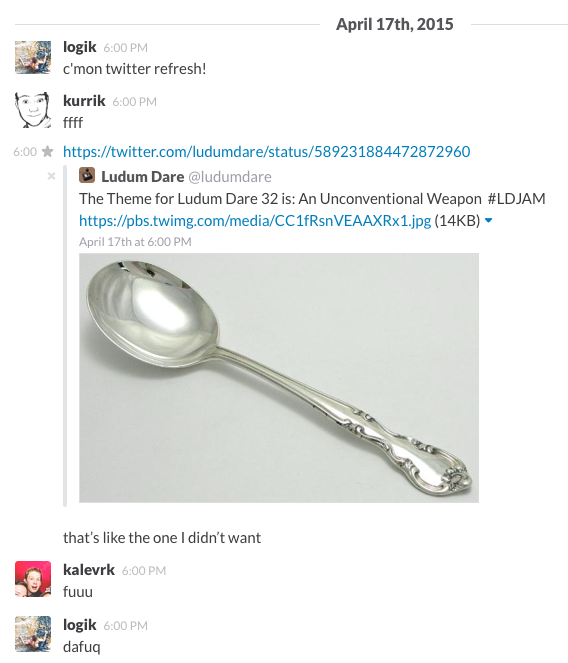
When I’m working on such a tight timeframe, trimming early and aggressively is my favorite way to stay on track. We always trimmed enemies from our previous games because they require a ton of work. Each enemy type needs animations, (minimally idle, walking, and attacking) for every direction they can face. Enemies typically need AI and pathfinding too—one of my first LD solo projects was a Bomberman clone. I didn’t have time to implement AI or pathfinding and just made the baddies roll a die to walk up, down, left, right, or drop a bomb. In that case, each enemy blew itself up in the first few seconds and the game was no fun at all.
The dirty secret about Ludum Dare is that if you want to do well, you should do a bunch of pre-planning for the weekend, including deciding on the type of game you want to make. So before LD32, we figured that making another top-down Zelda-like exploration game would be fun. I tuned twodee, our game library, to be able to handle big maps, and added a couple of interesting features such as the ability to shake the camera (a tribute to Titan Souls), draw lines, and have an in-memory grid representation of the map for the purposes of pathfinding.
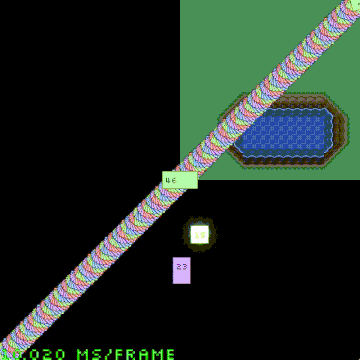
Once the theme for LD is announced, we always spend an hour coming up with a plan of what to build. But as the hour for LD32 ran out, we still didn’t know what the mechanic for the game would be. We figured we’d just start working on something Zelda-like and maybe the idea would come to us.
Titan Souls has the setup that the entire game is just a series of boss fights and there’s no enemies on the map itself. This is a bit of aggressive trimming (Titan Souls was initially a Ludum Dare game) and works out brilliantly. The main map is abandoned and moody, and the developers put all their time into making the boss fights fun. We figured we could do the same—if we were going to go ahead and make interesting enemies it would be more rewarding to have a few different big boss enemies and not have to worry about a bunch of things wandering around the map.
From that point, we had a ton of work to do just to get a map loading and an animating character running around (twodee isn’t the most streamlined yet), so I let Future Arne worry about the theme and set to work implementing various controls and simple collisions (something which should have been in twodee beforehand).
Collisions took longer than I wanted. Feels solid though. Updated engine lib so I don't need to do this again #LDJAM pic.twitter.com/Et1I4Ln5a8
— Arne Rಠ_ಠmann-Kurrik (@kurrik) April 18, 2015By the end of Friday, I must have been despairing a bit, as my Tweets all called out the lack of direction:
About 7 hours in & a cohesive plan of what we're building hasn't gelled yet. Lots of ideas and wants, worried about lacking vision #LDJAM
— Arne Rಠ_ಠmann-Kurrik (@kurrik) April 18, 2015Lots of engine work without a plan though. Top down adventure, added animations & roll & screen shake https://t.co/Q5lihsTlsn #LDJAM
— Arne Rಠ_ಠmann-Kurrik (@kurrik) April 18, 2015Off to bed shortly. Would have liked a core mechanic implemented today but good progress on the engine. Maybe sleep will give ideas #LDJAM
— Arne Rಠ_ಠmann-Kurrik (@kurrik) April 18, 2015I typically find that if I go to bed thinking about a problem, I can wake up the next morning with a solution. Not this time, though. I woke up and got some productive engine work done on Saturday but the harder I thought about what would make the game interesting, the less I came up with.
Until, like Archimedes before me, I took a break from the problem at hand for some light bathing and was struck by insight:
Took a shower at 24 hours in and had a Eureka! moment with the mechanic. Color is the weapon #LDJAM pic.twitter.com/iijWmB329k
— Arne Rಠ_ಠmann-Kurrik (@kurrik) April 19, 2015My idea was that instead of having an unusual sword-substitute, the character’s weapon would be the ability to change the color of the scene. Each boss would have a magic color which would inflict damage, so once the player figured out the correct color combination, the boss would take damage and the magic color would change.
What I really liked about this idea was that it let me play around with effects. Shaders were initially tricky to learn but now that I’ve wrapped my head around the concepts they’ve become one of my favorite parts of game development. In this case, coloring the scene was a really fast addition and we were able to get a proof of concept with some initial art together by Saturday night.
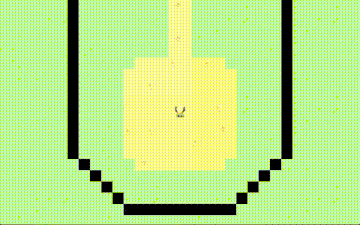
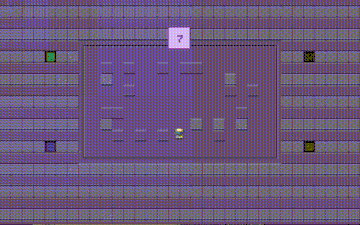
I also finally bit the bullet and did the animations for the boss character. Originally I was thinking we’d have multiple bosses but I completely ran out of time. In fact, I knew I only had enough time to do one set of animations, so I used combinations for the same set of frames for idle, moving, attacking, and dying. I also made the boss a symmetrical jelly cube so that I wouldn’t have to worry about making it face different directions. Hacky, but I like the way it turned out (hopefully evocative of D&D):
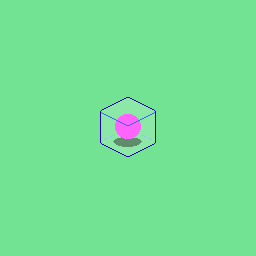
A quick modification to the effects shader let me change the color of the center circle to any arbitrary color. So the game is able to display what the boss’s magic color is and give you a hint about the colors you need to combine to damage it.
During this time, Wes was working on the boss pathfinding and UI. This is very hard to get right, so I was happy he was able to focus on it. We wound up needing to add a debug mode to the game which would show the boss’s pathfinding algorithm at work (good thing I put the ability to draw lines into the engine!). Being able to visualize algorithms in action is another great thing about game development - you can typically just draw more information on a scene in debug mode and get an intuition about any weird behavior you see.
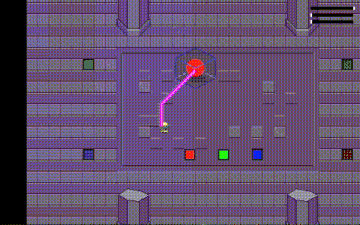
Eventually the pathfinding was good enough, and I had put in the stuff to make it a real game - the ability to win, the ability to lose, and splash screens which showed up whenever either of those things happened.
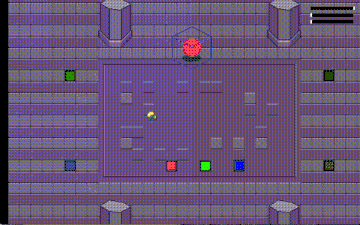
At the end of the day, we shipped our first game with an enemy. It’s not our best game—we wound up placing 374⁄1468 overall, which is our worst showing to date. But like everything else we’ve done so far, I like the mechanic, I’m proud of getting it done, and I feel like the idea has potential should we want to pick this up again and work on something similar.
I’m not sure if there’s much of a moral to this development log. Making games is hard, especially if you don’t have a strong inspiration. Ludum Dare’s themes have historically helped us focus our efforts but I feel like this one got in the way a bit. Personally, I feel like I learned at least a few more things:
It’s very difficult to juggle game design, programming, and art. It would have been better to have had a dedicated artist or scope down the art into basic geometric shapes. I think of this game as pretty (at least for my own art skills!) but not fun. I think I’d rather have had fun but not pretty.
Taking breaks to get up, move around, and focus on something else briefly can be hugely productive.
We would have benefitted greatly by tuning the boss behavior more - they just follow you around or give up if you get too far away. State machines should be easier to build in twodee.
Taking the theme too literally can make building the game too much of a slog. As an example, the Jam winner had a brilliant take on the theme without needing a ton of AI or violence. Figuring out the simplest possible mechanic early on and focusing on making it fun seems like the right way to go.
If you’re interested in playing Chromos, you can download it from this page. You can also see a collection of all my Tweets from the development in this Twitter Timeline which shows a bunch more images and animations from the development of the game.
Can’t wait until the next one!
Comments? If you have feedback, please share it with me on Twitter!